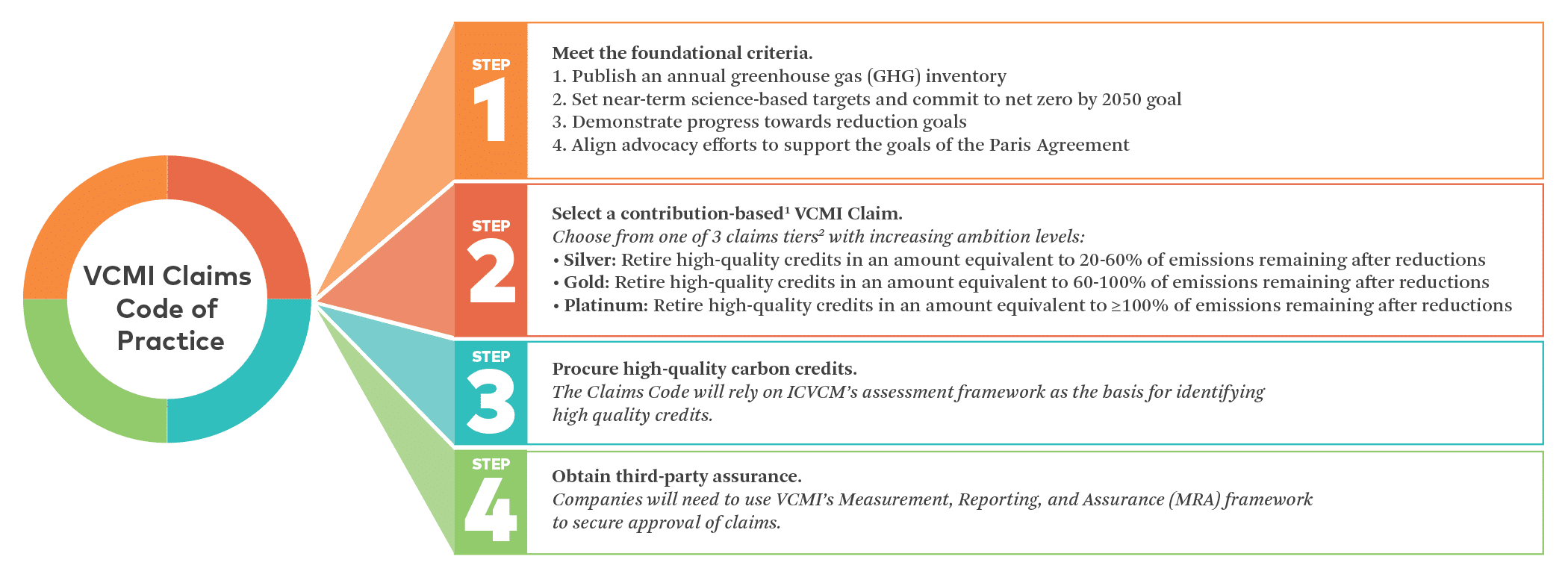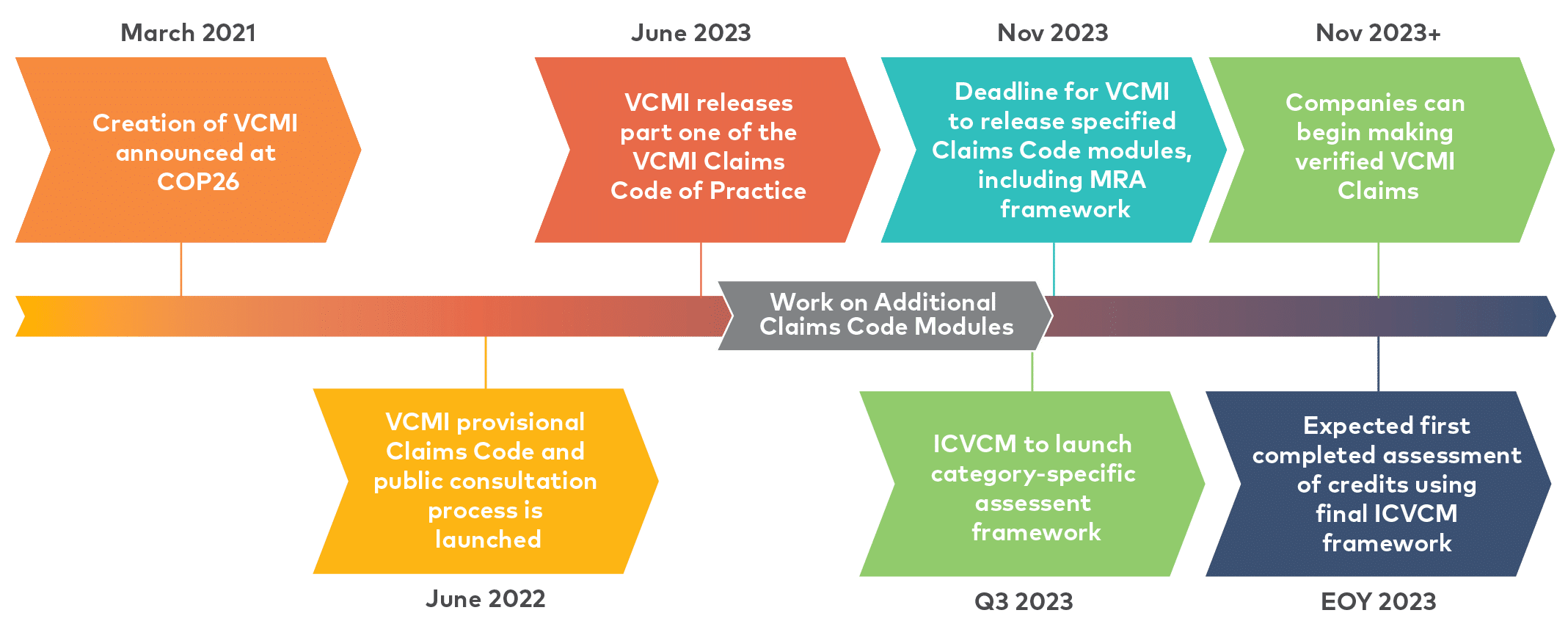The past few years have seen an unprecedented and ever-growing number of corporate commitments to combat climate change. Carbon credits represent one integral tool that companies with such goals can leverage to support their own claims and contribute to global climate change mitigation. As carbon credit-based claims have become more common, a jumble of terms and recommendations for credible action has also arisen, with many market participants expressing valid concerns that lack of standardization is causing confusion and hesitation at best, and greenwashing at worst.
To address these concerns and promote greater standardization, transparency, and clarity around the use of carbon credits, the Voluntary Carbon Markets Integrity Initiative (VCMI), a global non-profit dedicated to enabling a high integrity voluntary carbon market, released part one of its much anticipated Claims Code of Practice in June 2023. The Code aims to provide a clear, operable framework for corporations seeking to make credible carbon claims and for observers looking to assess the integrity of these claims.
Understanding the VCMI Claims Code of Practice
The VCMI Claims Code lays out an initial suite of high integrity claims, as well as the foundational criteria that organizations must meet before making any VCMI-aligned claim. From a 10,000 foot view, the guidance explains how companies should operationalize one major principle: direct emission reductions should be the top priority, and should not be treated as interchangeable with carbon credits from activities that mitigate emissions outside companies’ value chains. This is a principle that has already been endorsed by other widely-recognized corporate climate guidance, including the Greenhouse Gas Protocol and the Science-Based Targets Initiative.
VCMI’s Claims Code outlines a four-step process that companies must follow to make carbon credit claims in line with its guidance:

1VCMI specifies that claims must be contribution-based, meaning credits must be used for climate mitigation beyond a company’s internal decarbonization targets.
2VCMI may release additional tiering and naming systems in their second release in Nov 23
What does the Claims Code mean for organizations already making (or intending to make) claims based on the use of carbon credits?
Moving forward, all companies communicating carbon credit-based claims will face the important choice of whether or not to ensure their claims are VCMI-aligned. Organizations that decide to meet VCMI’s requirements (i.e., can set and show progress towards a near-term science-based target and commit to net zero emissions by 2050) can operate with greater confidence that their carbon strategies are in line with robust, third-party standards moving forward. It is likely that these organizations will also be aligned with other prominent voluntary carbon market guidance, as VCMI has announced close coordination with other leading guidance providers such as the Science-Based Targets Initiative (SBTi) and the Integrity Council for the Voluntary Carbon Market (ICVCM).
Companies should consider contribution-based claims
The Code also provides guidance and suggested language for companies navigating a shift towards “contribution-based” carbon credit claims. VCMI characterizes carbon credits as “contributions” to global climate change mitigation rather than tools to “offset” or compensate for ongoing value chain emissions. This solidifies a growing trend in the voluntary carbon market away from language that may imply carbon credits are interchangeable with direct emission reductions (e.g., “carbon neutral” or “reduced-carbon product” claims), towards a more transparent framing of the impact of carbon credits (i.e., contributing to mitigation beyond credit buyers’ own footprints). This trend has been fueled, in part, by efforts to implement Article 6 of the Paris Agreement, which allows countries to claim and trade carbon credits against their national emission reduction pledges, and has created confusion around acceptable carbon credit claims for non-government participants in the global voluntary carbon market. VCMI has provided an important indication of how companies can credibly claim to contribute to global mitigation using carbon credits, without countries having to formally relinquish the right to count the same emission impacts in their own national registries.
Companies must first align with SBTi guidance to make VCMI-aligned claims
However, VCMI’s requirements of an SBTi-aligned near-term target and a 2050 net zero commitment “in line with globally recognized sustainability frameworks” may significantly limit corporate adoption – and therefore the total emissions impact – of VCMI’s Code. Many companies remain unable to set goals in line with SBTi’s guidance, including certain hard-to-abate sectors (e.g., oil and gas), subsidiary companies of parent organizations, and (in many cases) small and medium enterprises. Throughout 2023, VCMI plans to develop a broader set of claims tiers and an “on-ramp” for companies that are not yet able to meet VCMI’s foundational criteria, which will be crucial for wider adoption and impact.
Companies with leading investment-based approaches may not conform to VCMI
In addition, VCMI’s decision to default in full to the ICVCM to identify acceptable credits and to require volumetric (“ton-for-ton”) matching of carbon credits to a company’s remaining emissions may limit adoption by companies with leading-edge carbon procurement strategies. Several companies seen as leaders in the voluntary carbon market have prioritized providing early-stage finance to nascent carbon reduction, removal, and storage technologies whose scale will be essential to stay on track to meet Paris Agreement targets. This is seen as a sophisticated, high risk, pioneering strategy because it comes with crucial tradeoffs: buyers likely receive very small credit volumes well into the future, with high risks of volume shortfall and non-delivery. Additionally, these buyers are often unable to rely on methodologies from major registries as a basic guarantee of credit quality due to the nascency of the reduction or removal approaches they choose to support. Because investment amounts, not credit volumes, are the focus of these organizations’ claims, and because ICVCM approvals will only be given to credits certified under approved programs (i.e., registries) and methodologies, it is unlikely that these types of buyers will be able to make VCMI claims unless the Code is expanded significantly.
What’s Next for the Claims Code of Practice?
With its first release of the guidance, VCMI also announced its plans to significantly expand upon the Code throughout 2023. Key areas VCMI has flagged to build out its framework include: the Measurement, Reporting, and Assurance (MRA) framework companies will need to use to validate VCMI claims, supplementary guidance for specific industries, sectors, and geographies, and potential new nomenclature for its claim tiers (per a review of marketing appeal), in addition to entirely new claims tiers and possible on-ramp option for companies who have not yet met VCMI’s foundational criteria.

While it remains to be seen how widely companies adopt this new guidance, VCMI’s Claims Code has introduced a new standard that can be a useful anchor point in examining the integrity of carbon credit claims moving forward. The Code’s strong assertion that companies must procure high-quality credits to contribute to global climate ambition while still prioritizing internal decarbonization is a welcome addition to the guidance landscape shaping the voluntary carbon market. Given the potentially limited applicability of this first release of VCMI’s guidance, we hope that the forthcoming release of industry- and geography-specific modules, as well as the much-anticipated Measurement, Reporting, and Assurance framework, will provide a clearer roadmap for companies at all stages of their sustainability journeys to take ambitious action in the voluntary carbon market and make credible carbon claims with confidence.
If you are considering making a carbon credit-based claim, shifting your carbon strategy to prioritize a contribution-based approach, or have any questions about what carbon market evolutions mean for your existing or forthcoming climate commitments, please reach out.
Tory Hoffmeister is a Manager on 3Degrees’ Energy and Climate Practice consulting team
Emma Friedl is a Consultant on 3Degrees’ Energy and Climate Practice consulting team




